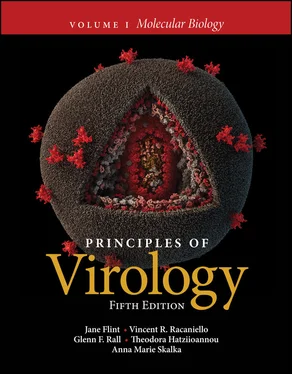Jane Flint - Principles of Virology, Volume 1
Здесь есть возможность читать онлайн «Jane Flint - Principles of Virology, Volume 1» — ознакомительный отрывок электронной книги совершенно бесплатно, а после прочтения отрывка купить полную версию. В некоторых случаях можно слушать аудио, скачать через торрент в формате fb2 и присутствует краткое содержание. Жанр: unrecognised, на английском языке. Описание произведения, (предисловие) а так же отзывы посетителей доступны на портале библиотеки ЛибКат.
- Название:Principles of Virology, Volume 1
- Автор:
- Жанр:
- Год:неизвестен
- ISBN:нет данных
- Рейтинг книги:5 / 5. Голосов: 1
-
Избранное:Добавить в избранное
- Отзывы:
-
Ваша оценка:
- 100
- 1
- 2
- 3
- 4
- 5
Principles of Virology, Volume 1: краткое содержание, описание и аннотация
Предлагаем к чтению аннотацию, описание, краткое содержание или предисловие (зависит от того, что написал сам автор книги «Principles of Virology, Volume 1»). Если вы не нашли необходимую информацию о книге — напишите в комментариях, мы постараемся отыскать её.
Volume I: Molecular Biology
Volume II: Pathogenesis and Control
Principles of Virology, Fifth Edition
Principles of Virology, Volume 1 — читать онлайн ознакомительный отрывок
Ниже представлен текст книги, разбитый по страницам. Система сохранения места последней прочитанной страницы, позволяет с удобством читать онлайн бесплатно книгу «Principles of Virology, Volume 1», без необходимости каждый раз заново искать на чём Вы остановились. Поставьте закладку, и сможете в любой момент перейти на страницу, на которой закончили чтение.
Интервал:
Закладка:
Single-cell studies have demonstrated that measurements of virus reproduction in populations of cells do not represent the diversity that exists among individual cells. Consequently, they will likely become a complementary tool to the one-step growth experiment for studying virus infection.
Perspectives
One-step growth analysis, while simple, remains a powerful tool for studying virus reproduction. When cells are infected at a high multiplicity of infection, sufficient viral nucleic acid or protein can be isolated to allow a study of their production during the infectious cycle. The ability to synchronize infection is the key to this approach. Many of the experimental results discussed in subsequent chapters of this book were obtained using such one-step growth analysis. The power of this approach is such that it reports on all stages of the reproduction cycle in a simple and quantitative fashion. With modest expenditure of time and reagents, virologists can deduce a great deal about viral translation, genome replication, and assembly. It has long been assumed from such one-step growth analyses that the same steps of the viral reproduction cycle occur at the same time in every infected cell. However, results from analyses of single infected cells demonstrate that the same steps can take place at vastly different times in individual cells in the population. We now understand that results from population-based studies of viral reproduction comprise an average of events occurring in individual cells. One-step growth analyses with single cells have the potential of unraveling the viral and cellular basis for such individual heterogeneity.

Figure 2.22 Single-cell virology. (A)A microfluidic device with 6,400 wells is fitted with four separate sample inlets (green) and pneumatic control lines (red) that permit each well to be sealed and isolated. A small part of the device is magnified at the top, showing an array of 24 wells, and four wells are further magnified to the left. (B)The device can be used to measure real-time fluorescence in cells infected with a virus encoding a fluorescent reporter. The production of fluorescence is shown in the graph and illustrated in the views of single cells in individual cells above. There is a lag in the detection of fluorescence in an infected cell (t i), followed by virus reproduction (t j) and a decline in fluorescence caused by cell lysis (t k). Reprinted from Guo F et al. 2017. Cell Rep 21:1692-1704, with permission.
From the humble beginnings of the one-step growth curve, many new methods have propelled our understanding of viruses and infected cells to greater depths and at unprecedented speed. An astounding array of technologies, including high-throughput sequencing, proteomics, and single-cell approaches, have been developed. These methods have already led to significant discoveries about viral evolution, reproduction, and pathogenesis. We are truly in a remarkable era, when few experimental questions are beyond the reach of the techniques that are currently available.
REFERENCES
Books
Green MR, Sambrook J.2012. Molecular Cloning: A Laboratory Manual , 4th ed. Cold Spring Harbor Laboratory Press, Cold Spring Harbor, NY.
Maramorosch K, Koprowski H (ed).1968. Methods in Virology . Academic Press, New York, NY.
A series of volumes begun in the 1960s that contain review articles on classic virological methods.
Review Articles
Dulbecco R, Vogt M.1953. Some problems of animal virology as studied by the plaque technique. Cold Spring Harb Symp Quant Biol 18:273–279.
Kuadkitkan A, Wikan N, Smith DR.2016. Induced pluripotent stem cells: a new addition to the virologists armamentarium. J Virol Methods 235:191–195.
Ramani S, Crawford SE, Blutt SE, Estes MK.2018. Human organoid cultures: transformative new tools for human virus studies. Curr Opin Virol 29:79–86.
van Dijk EL, Jaszczyszyn Y, Naquin D, Thermes C.2018. The third revolution in sequencing technology. Trends Genet 34:666–681.
Wang I-H, Burckhardt CJ, Yakimovich A, Greber UF.2018. Imaging, tracking and computational analyses of virus entry and egress with the cytoskeleton. Viruses 10:1–29.
Papers of Special Interest
Ellis EL, Delbrück M.1939. The growth of bacteriophage. J Gen Physiol 22:365–384.
A landmark paper describing the development of the plaque assay to measure infectivity of bacteriophage and its use in studying viral reproduction by one-step analysis.
Reed LJ, Muench H.1938. A simple method for estimating fifty percent endpoints. Am J Hyg 27:493–497.
An important paper that shows how to estimate 50% endpoints in titrations of viruses in animals.
Guo F, Li S, Caglar MU, Mao Z, Liu W, Woodman A, Arnold JJ, Wilke CO, Huang TJ, Cameron CE.2017. Single-cell virology: on-chip investigation of viral infection dynamics. Cell Rep 21:1692–1704.
A seminal paper that presents a pneumatic device for measuring infection of single cells with poliovirus and its use to measure the heterogeneity of infection.
STUDY QUESTIONS
1 Which of the following statements is not correct?The infectious cycle and virus reproduction are synonymousA susceptible cell has a functional receptor for a given virusA cell that is resistant to infection has the viral receptor but the virus cannot be reproduced in itVirus can be reproduced in a permissive cellA susceptible and permissive cell is the only cell in which a virus can enter and be reproduced
2 Which of the following statements about cytopathic effects (CPE) is correct?Some viruses may not produce cytopathic effects in certain cellsSyncytium formation is a type of CPERounding up and detachment of cultured cells is a type of CPEFormation of a viral plaque depends upon CPEAll of the above
3 Which of the following assays determines the number of infectious viral particles?ELISAHemagglutination assayPlaque assayHigh-throughput sequencingPolymerase chain reaction
4 If one million infectious virus particles are added to a culture dish of one million cells, which of the following will happen:Each cell will receive one virus particle because the MOI is 1None of the cells will receive any virus particles37% of the cells are uninfectedOnly one infectious cycle will take placeNone of the above
5 When doing a plaque assay, what is the purpose of adding a semisolid agar overlay on the monolayer of infected cells?To stabilize progeny virionsTo ensure that cells remain susceptible and permissiveTo act as a pH indicatorTo keep cells adherent to the plate during incubationTo restrict viral diffusion after lysis of infected cells
6 In the particle-to-PFU ratio, “particle” can best be described as:One of the proteins which makes up the virionA virus which may or may not be infectiousA virus which is infectiousA virus which is not infectiousElementary or composite
7 The plaque assay plate below was made from a dilution of 10–6 and 0.1 ml of the dilution was plated on the cell monolayer. What is the titer in PFU/ml?
Читать дальшеИнтервал:
Закладка:
Похожие книги на «Principles of Virology, Volume 1»
Представляем Вашему вниманию похожие книги на «Principles of Virology, Volume 1» списком для выбора. Мы отобрали схожую по названию и смыслу литературу в надежде предоставить читателям больше вариантов отыскать новые, интересные, ещё непрочитанные произведения.
Обсуждение, отзывы о книге «Principles of Virology, Volume 1» и просто собственные мнения читателей. Оставьте ваши комментарии, напишите, что Вы думаете о произведении, его смысле или главных героях. Укажите что конкретно понравилось, а что нет, и почему Вы так считаете.



